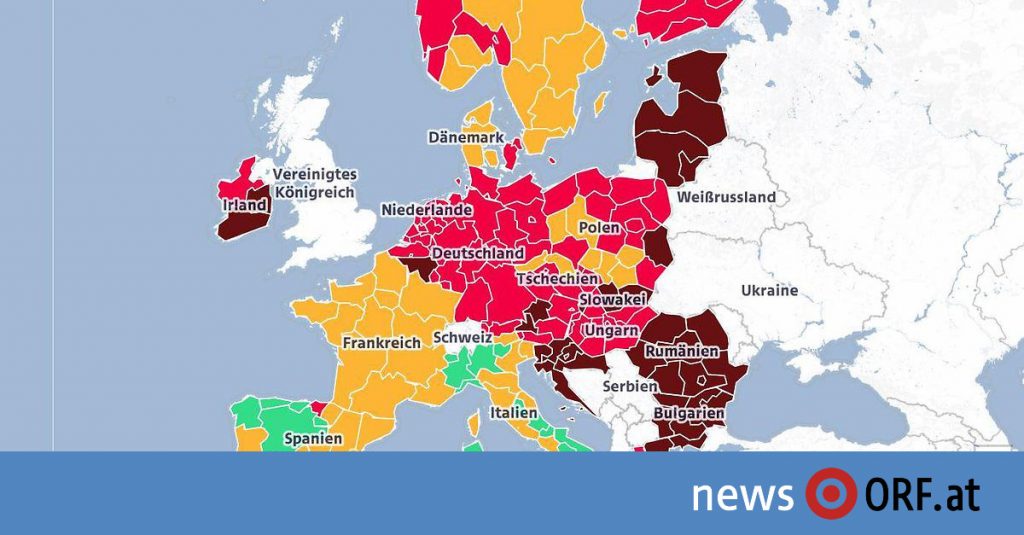A look at the current general map of the European Union’s Epidemiological Authority (ECDC) shows Europe in two parts when it comes to infections: on the one hand, yellow and green dominate, 14 days below 75 and 200 per 100,000 inhabitants, respectively. The other side is mostly red and even dark red, with incidence values between 200 and 500 and over 500.
This dividing line also runs along the Austrian border: in northern Italy, the infection process is relatively comfortable. Despite all the differences in numbers that different testing systems and other factors bring with them: Spain and Portugal in particular stand out on the map – not just in terms of incidence. Especially when it comes to vaccination rates, the Iberian Peninsula is at the forefront of Europe.
The situation has completely changed since the summer
The situation was practically reversed in August: the infection rate rose in Western Europe, while the rest of the European Union, including Austria, largely survived. But only two months later, events moved to the east, while the situation calmed down in the west. Complexity researcher Peter Klimeck told ORF.at that the “wave motion” itself “is not unusual”.
The linguistic and cultural proximity of the countries of South America favored this, according to Klimeck: intercontinental movements made the Iberian Peninsula an ideal starting point for the contagion process, where in the southern hemisphere winter during summer is another factor. This will not only be observed in the coronavirus, according to Klimeck.
Measures taken into effect even before vaccination
But the countries of western and southern Europe “stopped” in time, according to Klimeck. Initially, vaccination did not play such a major role: the high points of infection were there when the vaccination rate was “significantly lower”. The rapid increase, which was probably caused mainly by the delta variant, was sometimes met with strict measures.
Klimek mentions school closures, movement restrictions and curfews. Above all, the restrictions on nighttime gastronomy were intended not only to slow infection – but also to save the summer tourism season, which is so important for these countries.
Vaccination rate is high, few intensive care beds are occupied
With the increasing availability of the vaccine, countries have been catching up quickly: according to data from the European Center for Disease Control and Prevention, Spain was slightly above the EU average in July, but by mid-September it was already 10 percentage points higher than the average. Portugal is currently at the top of the Europa League when it comes to vaccination, and Spain is far ahead when it comes to vaccination rates.
This is also reflected in the hospital occupancy in the country of 47 million people: the Spanish Ministry of Health reported about 405 people in intensive care units on Tuesday, which corresponds to the occupancy of about four percent of intensive care beds with Covid. 19 patients are equivalent. In Portugal, which has a population of more than ten million, 59 people are in intensive care units, according to the local health authority – just one-sixth of the population in Austria.
An emergency that is difficult to control in Romania
Meanwhile, a very different picture is emerging in Eastern Europe: Romania in particular has made headlines lately. There the situation in intensive care units is completely out of control – infection values are among the highest in Europe. Last week, the European Union sent medical staff and equipment into the country, and patients were taken abroad for treatment.
In Romania, only about a third of the population is vaccinated – and even fewer people are vaccinated in Bulgaria, where, according to ECDC, only less than 22 percent are considered to have received the primary vaccination. After all: in both countries, the number of cases has decreased slightly in the past few days, but the situation in intensive care units is not declining at the moment.
On Thursday, the World Health Organization warned of a sharp rise in numbers across Europe. “The current rate of transmission in 53 countries in the European region is very worrying,” said European WHO chief Hans Kluge on Thursday. He added that the numbers of new cases are approaching record levels.
Lithuania and Austria have something in common
Meanwhile, Klimec also points to the Baltic states – Latvia at the forefront of Europe in terms of infection. But the researcher mentions Lithuania in particular: the country has a vaccination rate similar to Austria – the 14-day infection rate, according to the government, is almost 1,400, which is much higher than in Austria.
It is unclear whether the situation in Austria could develop in a similar way – for Klimeck, at least exhausting a step-by-step plan is certainly a scenario. “There is no doubt that there is a possibility if we do not change anything,” says the researcher. 400 families occupied in intensive care in this country “just days”.
At the border between east and west, green and red on the ECDC map, the question arises what can Austria glean from the behavior of other countries. In any case, the “wooden hammer methods”, as used in western and southern Europe in summer for containment, are no longer needed, Klimeck says. He points to Vienna: While the capital was still at the top in terms of the number of infections in mid-September, Vienna is now the federal state with minimal infection – without “particularly stringent” measures. Even small changes will make a noticeable difference here, according to the complexity researcher.

“Total coffee aficionado. Travel buff. Music ninja. Bacon nerd. Beeraholic.”








More Stories
Coral Seeding: Artificial Insemination Makes Coral More Heat Tolerant
Fear, Anger, and Denial: How People Respond to Climate Change – Research
LKH Graz: Using radiation to combat heart arrhythmias